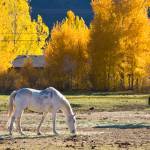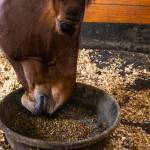Equine Pasture Planning

So, what’s to plan about a pasture? You fence in some land and add water and horses, right? That will work, of course, but in a year or so you may realize that a little planning could have saved you some headaches.
Things to think about include:
- Purpose. Will your pasture provide grazing, or be mostly an exercise area? Will you be installing a cross-country jump course in the field, or rotating between grazing and mowing for hay? Will you build a barn, house, or other structure on this land at some time in the future, and will today’s use impact tomorrow’s plan?
- Field size. How much land will each horse need? This varies from an acre or two in areas with excellent grazing to 10, 20, or more acres in dry areas with patchy forage. If you are planning to turn out horses in groups, be sure they will have enough space and forage. Making two or three smaller fields instead of one enormous pasture means you can rotate areas for grazing, and also makes it somewhat easier to catch uncooperative horses.
- Herd size and composition. Maybe you have only one gelding right now. What if you get a stallion at some point, or mares and foals, or older horses that need a quiet place to relax? Again, several small fields might be preferable to one large pasture.
- Water. Can you design your fields so that one water line or tank can serve several areas? Do you want to put your water source in a fenced area so that horses have to visit the smaller pen several times a day, allowing you to snare that pony that’s hard to catch? If you do this, be sure you are not setting your water tank in a position where one bossy horse can block access for the others. Within reason, avoid putting the water tank in a low, wet area, as you will soon have bare earth (mud) in this spot anyway.
- Shelter. Consider hills, groves of trees, creek valleys, and other natural windbreaks, or build run-in sheds so horses can seek shelter from sun, wind, and rain. Run-in sheds can be constructed back-to-back to serve two fields, but don’t face either shed into your region’s prevailing wind.
- Gates. Are they wide enough for farm vehicles and mowing equipment? Are they in convenient locations for moving horses? Does a particular field need more than one gate?
- Spacing. If you have horses in adjacent paddocks and don’t want to allow contact between different groups, leave a lane between fences. Be sure the lane is wide enough to lead a horse and have it out of range of curious horses on both sides. To allow tractors and mowers to be driven along the lane, a width of 16 feet is probably adequate.








